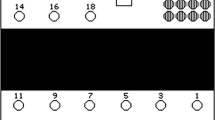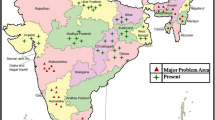Abstract
Six insect pests of potato, green peach aphid,Myzus persicae (Sulzer); potato leafhopper,Empoasca fabae (Harris); Colorado potato beetle,Leptinotarsa decemlineata (Say); tarnished plant bug,Lygus lineolaris (Palisot de Beauvois); red-legged grasshopper,Melanoplus femurrubrum (DeGeer); and southern army worm,Prodenia eridania (Cramer), were tested for their ability to transmit potato spindle tuber viroid (PSTV). PSTV infection was determined by a gel electrophoretic assay made 6 weeks after transfer of insects from infected to non-infected plants of the cultivar, ‘Katahdin.’ Plants grown from tubers of the original non-infected hosts were also assayed. PSTV was detected in only 2 of 183 test plants; these 2 plants had been infested with the tarnished plant bug. These results suggest that the insect species studied are relatively insignificant as vectors of PSTV.
Resumen
Seis insectos plagas de la papa: el pulgón de la papa,Myzus persicae (Sulzer); el saltahojas de la papa,Empoasca fabae (Harris); el escarabajo de Colorado,Leptinotarsa decemlineata (Say); el chinche manchado,Lygus lineolaris (Palisot de Beauvois); el grillo de patas rojas,Melanoplus femurrubrum (DeGeer); y el gusano ejército del surProdenia eridania (Cramer), fueron enzayados para determinar su capacidad de transmitir el viroide causal del tubérculo ahusado de la papa (PSTV). Infección por PSTV fué determinado con analisis de “gel electrophoresis” hecho seis semanas después de la transferencia de los insectos de plantas infectadas a no-infectadas, de la variedad “Katahdin.” Plantas nacidas de tubérculos huéspedes originales no-infectados fueron analizados también. PSTV fué detectado en unicamente 2 de las 183 plantas probadas; estas 2 plantas habían sido infectadas conLygus lineolaris. Estos resultados implican que las especies de insectos estudiados son relativamente no-significantes como vectores de PSTV.
Similar content being viewed by others
Literature Cited
Bonde, R. and D. Merriam. 1951. Potato spindle tuber control. Maine Agric Expt Stn 487. 15 pp.
Folsom, D., E.S. Schultz, and R. Bonde. 1926. Potato degeneration diseases: natural spread and effect upon yield. Maine Agric Expt Stn Bull 331:57–112.
Goss, R.W. 1928. Transmission of potato spindle-tuber by grasshoppers (Locustidae). Phytopathology 18:445–448.
Goss, R.W. 1931. Infection experiments with spindle tuber and unmottled curley dwarf of the potato. Neb Agric Expt Stn Res Bull 53. 36 pp.
Henry, S.M. 1962. The significance of microorganisms in the nutrition of insects. Trans NY Acad Sci Ser II, 24:676–83.
House, H.L. 1965. Digestion.In The Physiology of the Insecta. Ed. by M. Roskstein. II:815–58. Academic Press, New York, 905 p.
MacLachlan, D.S. 1960. Potato spindle tuber in eastern Canada. Am Potato J 37:13–17.
Merriam, D. and R. Bonde. 1954. Dissemination of spindle tuber by contaminated tractor wheels and by foliage contact with diseased potato plants. Phytopathology 44:111 (Abst.)
Miles, P.W. 1972. The saliva of Hemipters. Adv Insect Physiol 9:183–255.
Morris, T.J. and E.M. Smith. 1977. Potato spindle tuber disease: Procedures for the detection of viroid RNA and certification of disease-free potato tubers. Phytopathology 67:145–150.
Morris, T.J. and N.S. Wright. 1975. Detection on polyacrylamide gel of a diagnostic nucleic acid from tissue infected with potato spindle tuber viroid. Am Potato J 52:57–63.
Schumann, G.L. 1978. Studies of potato spindle tuber viroid and its detection by polyacrylamide gel electrophoresis. Ph.D. Thesis. Cornell University. 156 pp.
Schumann, G.L., H.D. Thurston, R.K. Horst, S.O. Kawamoto, and G.I. Nemoto. 1978. A comparison of tomato bioassay with slab gel electrophoretic assay for the detection of potato spindle tuber viroid in potato. Phytopathology 68:1256–1259.
Tingey, W.M., T.F. Leigh, and A.H. Hyer. 1973. Three methods of screening cotton for oviposition non-preference by lygus bugs. J Econ Entomol 66:1312–14.
Tingey, W.M., T.F. Leigh and A.H. Hyer. 1975.Lygus hesperus: growth, survival, and egg laying resistance of cotton genotypes. J Econ Entomol 68:28–30.
Werner, H.O. 1925. The spindle-tuber disease —one cause of “run-out” of seed potatoes. Nebr Agric Expt Stn Bull 207. 128 pp.
Author information
Authors and Affiliations
Additional information
Former Graduate Research Assistant, Department of Plant Pathology, Cornell University, Ithaca, New York, 14853.
Rights and permissions
About this article
Cite this article
Schumann, G.L., Tingey, W.M. & Thurston, H.D. Evaluation of six insect pests for transmission of potato spindle tuber viroid. American Potato Journal 57, 205–211 (1980). https://doi.org/10.1007/BF02854232
Received:
Issue Date:
DOI: https://doi.org/10.1007/BF02854232




